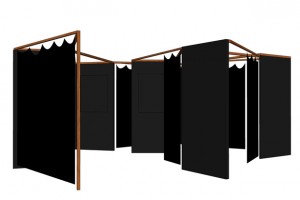Temporary Autonomous Research
Falke Pisano, Jeremiah Day, Nicoline van Harskamp
Curator: Henk Slager
October 2–December 31, 2012
9th Shanghai Biennale, Reactivation
Location: Power Station of Art
200 Hua Yuan Gang Road, Shanghai
That novel curatorial project with a presentation of worldwide platforms involving cities related in some way to Shanghai will show art practices closely connected to the theme of the current Shanghai Biennale. Cities such as Auckland, Bandung, Berlin, Tehran, Moscow, Vancouver, Istanbul, Dakar, Detroit and Amsterdam are all cities invited to participate in the city pavilions.
The City of Amsterdam is characterized by an important historical connotation: it has always been a transparent synonym for a refuge for diversity, for thinking and being different-than-others. Amsterdam could, therefore, be understood as a potential temporary autonomous environment where non-conformist forms of research and knowledge production have continuously been offered shelter since the early days of the 17th century. This inextricable form of signification understood in a broad and metaphorical sense is the point of departure for the themes the Amsterdam Pavilion will address during the 9th Shanghai Biennale.
What does thinking in terms of a temporary autonomy actually mean for topical art practices immersed in research-based forms and perspectives? Is there a direct connection between a temporary autonomous situation and the generation of critical artistic research? These are the questions the Amsterdam Pavilion will delve into further through its presentation TAR (Temporary Autonomous Research). TAR will show work of three artists with a specific focus on how to re-think history. From an idiosyncratic perspective, they research historical paradigms, the construction of historical facts, and historical movements while demonstrating how autonomous artistic thinking adds novel dimensions to how we understand the world.
Falke Pisano’s project The Body in Crisis investigates what role representation can play in staging the experience of a continuous state of crisis the body winds up in as a consequence of political, social, and economic transformations throughout history. What kind of forces affect the body? How do historical representations function in their original contexts? And most importantly, how could one activate historical turns and their relevance for the current conditions within topical visual art? In the formalization of the distance inherent in each representation, Pisano specifically notices possibilities to arrive at a temporary, permanently repeating obstruction and a liberation of the semiotic triangle of object-representation-subject.
Jeremiah Day’s work LA Homicide departs from the website of the Los Angeles Times. On that site, the newspaper gives a historical account of the daily victims of street violence in the “global slums” of Los Angeles. Day deploys these historical data as starting point. He visits the crime scenes, photographs them, and provides them with handwritten comments. In combination with cinematographic observation, these texts produce a certain connection between brutal, historical reality and the topical Hollywood paradigm that, resigned in a certain fatal consciousness, no longer believes in the narrative of the problem-solving capacity of human beings. Against this anthropological condition, artists can only place their own body, Day claims, a performative act entirely in line with Hannah Arendt’s thought where action is understood as an autonomous activity in public space.
Nicoline van Harskamp’s research, Yours in Solidarity, demands attention for anarchism as a historical movement. To that end, Van Harskamp analyses correspondences of late 20th-century Amsterdam protagonists. Her project consists of an archiving textual, presentation of original quotations articulating various aspects of the once personally experienced and spent moments of micro-politics. In addition, interviews are conducted with actors playing the authors of the letters. From our time dominated by a post-fordist concept of performance and a neo-liberal context prioritizing the economic realm, the actors speculate how they would re-think and re-activate an awareness of the “temporary autonomous zone.”
The Amsterdam Pavilion links and matches its questions and issues with ‘the academy of reciprocal enlightenment’, one of the sub-themes of the 9th Shanghai Biennale, since TAR implicitly thematizesthe institutional conditions and constituents of art education. The art school could be considered the last temporary autonomous zone: an experimental, free space for critical research, artistic thinking and non-conformist production of novel knowledge and alternative perspectives. In such a temporary autonomous zone promoting temporary autonomous research, the human condition and its forms of representation are necessarily re-thought, re-actualized and re-activated in a continuous flow.
Curator: Henk Slager, Dean MaHKU (Utrecht Graduate School of Visual Art and Design), visiting professor of Artistic Research (Finnish Academy of Fine Arts, Helsinki), and curator of a.o. Flash Cube (Leeum, Seoul, 2007), Translocalmotion (7th Shanghai Biennale 2008), Nameless Science (Apex Art, New York, 2009), Critique of Archival Reason (RHA Dublin 2010), As the Academy Turns (Collaborative project Manifesta, 2010), Any-medium-whatever (Georgian Pavilion, Venice Biennale, 2011) and Offside Effect (1st Tbilisi Triennial, 2012).
Publication: In the context of the Amsterdam Pavilion, a special publication will be issued by Metropolis M Books this October with contributions by Ilse van Rijn, Oliver Marchart, Henk Slager, and the participating artists. More information here.
The Amsterdam Pavilion project is made possible by support of the Amsterdam Fund for the Arts, Utrecht School of the Arts, Dutch Consulate Shanghai and Anything is Possible.


